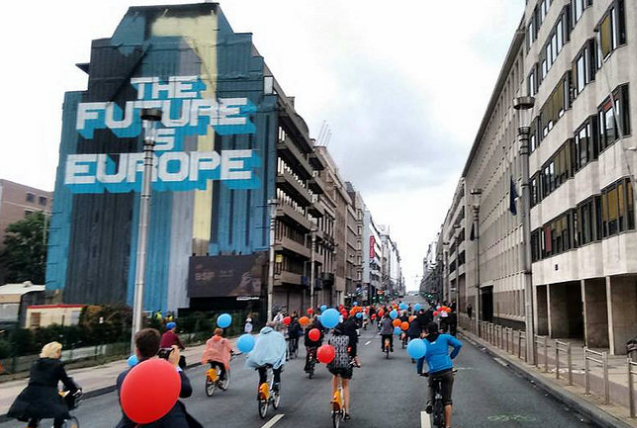The “EU Cycling Strategy. Recommendations for Delivering Green Growth and an Effective Mobility in 2030” is the result of a systematic review of all EU policies related to cycling wherein approximately 1,000 people were involved. It is a joint project and campaign of the Expert Group Members (see below) aimed at increasing cycling and bringing substantial added value to EU policy goals. Devised to inspire the EU Commission to develop their own EU Cycling Strategy, we want to remove fragmentation in the development of relevant policies across EU institutions and avoid inefficiencies in the expansion of local cycling strategies.
Full document of the EU Cycling Strategy here. Summary here.
Central Objectives
1) Cycling should be an equal partner in the mobility system 2) Grow cycle use in the EU by 50% at an average in 2019/2020 - 2030 3) Cut rates for cyclists killed and seriously injured by half (in km cycled) in 2019/2020 - 2030 4) Raise EU investment in cycling to €3bn in 2021-27 period; and €6bn from 2028-34
About the Campaign

Brussels by bike (part of the Big Bike Event organized by the three Benelux Permanent Representations to the EU on the 28th of June 2017)
On June the 16th we published the EU Cycling Strategy, handed it over to the EU Commissioner for Transport, Violeta Bulc, at the Velo-city conference and sent an open letter to the European Commission.
The publication and public handover of the EU Cycling Strategy was the highlight of our campaign. On the same day, we sent an open letter, endorsed by cities, regions, countries, other elected representatives, businesses, NGOs, academics and research institutions, to EU Commission President Juncker. In all instances, we call upon the EU Commission to include the development of an official EU Cycling Strategy in the Commission Work Programme 2008 or subsequent initiatives. By lowering barriers to cooperation, reducing coordination costs and increase information-exchange between Member States, the Commission can unlock cycling’s socio-economic and environmental potential in areas where local, regional and national authorities are currently lacking behind.
Two weeks later on June 28, we introduced the EU Cycling Strategy in Brussels at the Big Bike Event jointly organized by the transport teams of the Permanent Representations of the three Benelux countries to the EU. The Commission replied positively to our call by stating its will to land the cycling strategy as part of the 2018 initiative on multimodality.
To see the entire timeline of steps taken during the process and who was involved in the formulation, go to the EU Cycling Strategy Roadmap
About the Content Development
This strategy document has been put together by an expert group with 27 members, representing 15 governmental and non-governmental organisations, academia and business representations (see list below) which met three times in Brussels. In addition, input was collected over 8 months (September 2016 – May 2017) from a wider set of stakeholders: 7 public events/workshops (250 persons), a survey (more than 630 persons and organisations from 37 countries) and an online consultation (60 individuals and organisations) – approximately a 1,000 individuals were involved in the process of formulating the strategy.
The recommendations of the own-initiative report of the Committee of the Regions ‘An EU Roadmap for Cycling’ were also taken into account.
Expert Group Members
Catholic University Leuven (Leuven Mobility Research Center), Belgium |
Thérèse Steenberghen |
Leader of Chapter 11 |
CONEBI - Confederation of the European Bicycle Industries |
Manuel Marsilio |
Leader of Chapter 8 |
CROW, Netherlands |
Hillie Talens |
Leader of Chapter 4 |
Cycling Embassy of Denmark |
Mai–Britt Kristensen |
Leader of Chapter 3 |
Department of Transport – Ministry of Sustainable Development and Infrastructure of Luxembourg;Permanent Representation of Luxembourg to the EU |
Christophe Reuter;Sam Weissen |
Leader of Chapter 10 |
ECF – European Cyclists’ Federation |
Adam BodorMarcio DeslandesHolger HauboldZoe KruchtenFabian KüsterEdward LancasterKevin MayneRandy RzewnickiBenedicte SwennenEmelie de WagtCeri Woolsgrove |
Overall coordination;Leader of Chapter 1 and 2 and Annex SDGs |
EPHA – European Public Health Alliance |
Nina Renshaw |
Leader of Benefits Annex |
ETSC – European Transport Safety Council |
Ellen Townsend |
Leader of Chapter 5 |
European Commission |
Piotr Rapcz |
Observer |
GIZ – German Development Agency |
Jakob Baum |
Leader of Chapter 9 |
Green Budget Europe |
Bridget Farrel |
Leader of Chapter 7 |
Federal Ministry of Agriculture, Forestry, Environment and Water Management, Austria |
Martin Eder |
Cross-chapter contribution |
Ministry of National Development, Cycling Coordination Department, Hungary |
Miklos Berencsi |
Cross-chapter contribution |
Polis |
Florinda Boschetti |
Leader of Chapter 6 |
Transport for London, United Kingdom |
Brian Deegan |
Cross-chapter contribution (3, 4, 5) |
UCI – Union Cycliste Internationale |
Michael Brennan |
Cross-chapter contribution |
Estimated impact of adoption and implementation of a European Cycling Strategy
• A raising of the number of cycling trips in the EU from 160m per day (2017) to 240m by 2030
• Road safety - cyclists killed per 100m km cycled - cut from 1.6 (2014) to 0.8
• Economic benefits - growing the EU cycling economy from €513bn (2016) to €760bn (2030)
• Job creation - increasing jobs linked to cycling from 650,000 (2016) to 875,000 (2030)
• Supporting the electric-powered assisted bicycle (EPAC) market; strengthening the present European leadership in this high value segment of the bicycle market. Projected impact is the growth of the electric-powered assisted bicycle fleet - from 6.5m (2015) to 62m (2030)
Added Value of Cycling to EU Policy Goals
Cycling is of substantial added value to EU policy goals considering low emission mobility, growth and jobs in a thriving bicycle manufacturing and cycling tourism industry, multimodality and integration in the Intelligent Transport System, a level playing field for cycling alongside other transport modes, a focus on urban mobility, improved infrastructure and road safety, and the promotion of physical activity and health.

